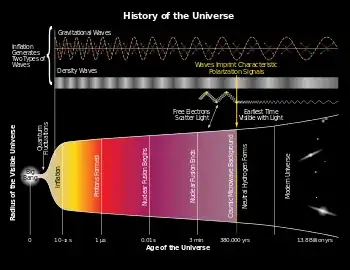How do we know that space expanded faster than a speed of light in inflation?
I have read this Phys.SE question, and it says that limit for faster than a speed of light is for matter and waves only.
I mean isn't edge of universe is determined by something being there like waves or matter?
Cause if there are no waves and no matter - then how does one know that space is there? How can one tell that space is there or not if there is no matter nor waves there with which one could interact, how could one differentiate from space being there and not being there? But then if waves or matter are required to be there for us to know that this is where the edge is, how then universe could expand faster than a speed of light? I must be missing something obvious here, please forgive me I am not a physicist.
- 1,135
2 Answers
How do we know that space expanded faster than a speed of light in inflation?
Let us start from the beginning, on the reason that the Big Bang theory was proposed as a model for the universe. The reason was the observations that all clusters of galaxies were receding from each other. This is what happens from an explosion at the center, in three dimensions. Within the framework of General Relativity it was proposed that the universe started from one singularity, and a particular solution was proposed and modeled the data up to a point, called the Big Bang.
Inflation came in to try and explain other observations, in fact the cosmic microwave background (CMB) measurements . They show a very homogeneous universe, because even though the maps show hotter and colder regions, the differences are smaller than 0.0002 Kelvin . In the old Big Bang model homogeneity could not be attributed to the universe reaching a thermodynamic equilibrium during the creation of nuclei, because by then the universe was too large for all of it to be able to communicate thermodynamically with velocity of light interactions and homogenize the temperatures.
Thus inflation was imposed for the very beginning after the hypothesized singularity, a time where quantum dynamical interactions homogenized the universe to create the levels of homogeneity obsered in the CMB.

Current BB model
Cause if there are no waves and no matter - then how does one know that space is there? How can one tell that space is there or not if there is no matter nor waves there with which one could interact, how could one differentiate from space being there and not being there?
You are correct in this, that is why one talks of the "observable universe" The models fit the observable universe.
But then if waves or matter are required to be there for us to know that this is where the edge is, how then universe could expand faster than a speed of light?
Models can be extrapolated to currently unobservable parts . We observe their imprint in the CMB, (370000 years after the BB) and maybe, if BICEP2 results hold, in the imprint of the gravitational waves on the CMB (10^-32 seconds after the BB), and using the equations of the current BB model we know that now a part of the then universe is inaccessible to us because the equations tell us that it has/is receded/ing with velocities larger than the velocity of light. See the answer by CuriousOne on this.
- 236,935
Inflation does not violate any local speed of light physics and there is no global prohibition in general relativity against spacetime points that are moving away from each other faster than the speed of light. Such spacetime points are simply not causally connected, i.e. there is no physical way to communicate between them (since light signals from one can not reach the other point). What this means is that we can not look "beyond" the event horizon of the local universe. We don't know what is "outside" of this event horizon. If inflation is correct, the universe may be much, much larger than the part that we can see.
Or maybe the inflation hypothesis is not correct, and something else happened that has similar consequences for the homogeneity as inflation. What could that be?
For instance, the universe could have existed before T_cosmological=0, and it may have been in a well mixed state (i.e. homogeneous) well before T_cosmological even began. This happens in "big bounce" models.
Or the speed of light could be vastly faster at ultrahigh energies, which would allow the initial universe to homogenize much quicker than what we calculate using general relativity and quantum mechanics.
Or general relativity needs a modification, like by adding torsion leading to what's called Einstein-Cartan theory. If I understand correctly, in that model the universe was never arbitrarily small, the big bang starts with a finite size, which also seems to help to make it more homogeneous.
I am sure the theorists here will have some arguments why all of my pet models have already been ruled out (in which case I apologize for talking nonsense!).
The important takeaway for everybody (physicists and non-physicists alike) is that it's important to keep an open mind about several possibilities.
- 16,486